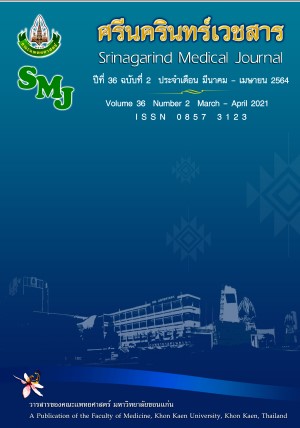Chest Wall Thickness at a Proper Area for Insertion of Intercostal Chest Drainage
Keywords:
chest trauma; intercostal chest drain; tension pneumothorax; chest injuryAbstract
Background and objectives: Nowadays, the areas for insertion of tube thoracostomy are mostly applied in the safety triangle area (lateral border of pectoralis major muscle, anterior border of latissimus dorsi muscle and the nipple line). The thicker chest wall may contribute to difficult tube thoracostomy insertion. So, cadaveric chest walls are measured for thickness to confirm appropriateness of safety triangle.
Methods: The fresh cadaveric chest wall was measured by the needle tapping the chest wall within the safety triangle combined with sternotomy to determine the thinnest area of the chest wall. The measured values are recorded in millimeters (mm.). The mean thickness of the chest wall, standard deviation (SD), BMI of the cadaver before preparation were studied
Results: The 20 fresh cadaveric chest walls were measured for thickness. The mean chest wall thickness within the safety triangle varies between 14.4 mm. to 23.9 mm. The areas with more than 50 mm thickness were mostly found in the mid-axillary line and two cases (54 and 56 mm.) in the 3rd intercostal space crossing with anterior axillary line. While the thinnest areas (14.4 mm.) are found within 7th intercostal space. Most female cadavers have thicker chest wall than male.
Conclusion: Some areas in the safety triangle for tube thoracostomy insertion are more than 50 mm. in thickness. The area for insertion of the tube thoracostomy should be carefully selected, especially in woman and the obese patients. Moreover, insertion below 6th intercostal space should be avoided due to risk of peritoneal penetration.
References
2. Peter I Tsai, Matthew J Wall Jr, Kenneth L Mattox. Trauma Thoracotomy - General Principles and Techniques. In: Earnest E Moore, David V Feliciano, Kenneth L Mattox, Editors. Trauma 8th edition. New York: McGraw Hill, 2017: 473-478.
3. Laws D, Neville E, Duffy J. BTS guidelines for the insertion of a chest drain. Thorax. 2003 May; 58: 53-59.
4. Inaba K, Karamanos E, Skiada D, Grabo D, Hammer P, Martin M, et al. Cadaveric comparison of the optimal site for needle decompression of tension pneumothorax by prehospital care providers. J Trauma Acute Care Surg. 2015; 79: 1044–1048.
5. Chang SJ, Ross SW, Kiefer DJ, Anderson WE, Rogers AT, Sing RF, et al. Evaluation of 8.0-cm needle at the fourth anterior axillary line for needle chest decompression of tension pneumothorax. J Trauma Acute Care Surg. 2014; 76:1029–1034.
6. Inaba K, Ives C, McClure K, Branco BC, Eckstein M, Shatz D, et al. Radiologic evaluation of alternative sites for needle decompression of tension pneumothorax. Arch Surg Chic Ill 1960. 2012; 147: 813–818.
7. Laan DV, Vu TDN, Thiels CA, Pandian TK, Schiller HJ, Murad MH, et al. Chest wall thickness and decompression failure: A systematic review and meta-analysis comparing anatomic locations in needle thoracostomy. Injury. 2016; 47: 797–804.




